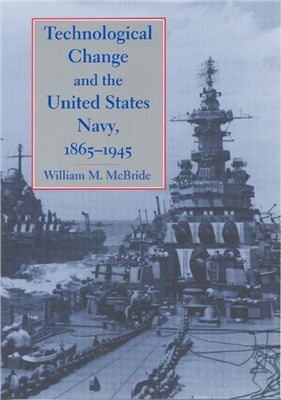Baltimore: The Johns Hopkins University Press, 2000. - 352 р.
Navies have always been technologically sophisticated, from the ancient world's trireme galleys and the Age of Sail's ships-of-the-line to the dreadnoughts of World War I and today's nuclear-powered aircraft carriers and submarines. Yet each large technical innovation has met with resistance and even hostility from those officers who, adhering to a familiar warrior ethos, have grown used to a certain style of fighting. In Technological Change and the United States Navy, William M. McBride examines how the navy dealt with technological change—from the end of the Civil War through the "age of the battleship"—as technology became more complex and the nation assumed a global role. Although steam engines generally made their mark in the maritime world by 1865, for example, and proved useful to the Union riverine navy during the Civil War, a backlash within the service later developed against both steam engines and the engineers who ran them. Early in the twentieth century the large dreadnought battleship at first met similar resistance from some officers, including the famous Alfred Thayer Mahan, and their industrial and political allies. During the first half of the twentieth century the battleship exercised a dominant influence on those who developed the nation's strategies and operational plans—at the same time that advances in submarines and fixed-wing aircraft complicated the picture and undermined the battleship's superiority.
Navies have always been technologically sophisticated, from the ancient world's trireme galleys and the Age of Sail's ships-of-the-line to the dreadnoughts of World War I and today's nuclear-powered aircraft carriers and submarines. Yet each large technical innovation has met with resistance and even hostility from those officers who, adhering to a familiar warrior ethos, have grown used to a certain style of fighting. In Technological Change and the United States Navy, William M. McBride examines how the navy dealt with technological change—from the end of the Civil War through the "age of the battleship"—as technology became more complex and the nation assumed a global role. Although steam engines generally made their mark in the maritime world by 1865, for example, and proved useful to the Union riverine navy during the Civil War, a backlash within the service later developed against both steam engines and the engineers who ran them. Early in the twentieth century the large dreadnought battleship at first met similar resistance from some officers, including the famous Alfred Thayer Mahan, and their industrial and political allies. During the first half of the twentieth century the battleship exercised a dominant influence on those who developed the nation's strategies and operational plans—at the same time that advances in submarines and fixed-wing aircraft complicated the picture and undermined the battleship's superiority.

